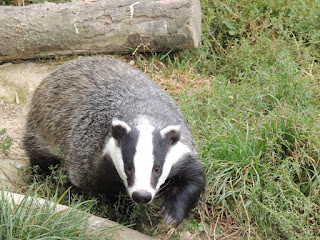Sometimes, if I’m lucky whilst out walking or in the car, I catch a glimpse of a wild creature – often a squirrel or rabbit. I’ve seen quite a few deer, too, and foxes, hedgehogs, weasels. On one memorable occasion, I saw a mole. There are wood mice living in my garden, and frogs and newts too, as well, of course, as the birds that I can watch from my hideaway bower.
However, if you really would love to be able to see a great selection of British wildlife life, I recommend a visit to the British Wildlife Centre at Lingfield, Surrey. This is yet another of my favourite, special places, and I go there regularly. Not only can you see most of Britain’s mammals, including the harder-to-find ones such as polecats, pine martens, red squirrels, otters and wildcats, you can see adders, grass snakes, marsh frogs and even nocturnal animals such as bats and dormice.
The otters are favourites, too. I could watch these elegant, streamlined playful creatures for hours. Unlike many other water creatures, otters are equally at home on land – they romp on the grass, twisting and turning as they wrestle with each other, before a grand chase makes them sprint back to the water. There they gracefully dive, disappearing and reappearing, with just a few bubbles marking the surface, showing where they are.
One of the nicest things about the British Wildlife Centre is the programme of talks. Throughout the day, informative talks are given at the various enclosures, and the animals are fed at the same time. It’s a marvellous opportunity to see some of the rarer creatures close up, and the keepers really know their stuff. The wildcats, for example, will venture to grab some food before slinking away to a favourite branch to eat, while the beautifully-marked pine marten just adores licking strawberry jam from a keeper’s fingers!
I was thrilled to see a grass snake gliding through the water searching for fish – what a beautiful, elegant reptile it is. The adders, in the next enclosure, were warming their coiled bodies, the warning V-shaped markings on their heads glinting in the sun. A fat water vole was scooping up duckweed, I didn’t realise that they enjoyed eating that, but this one certainly did. An inscrutable huge marsh frog was watching him. The russet coats of the foxes were glowing in the autumn sunshine. They were relaxing on the grass, yet their ears were pricked, listening no doubt for their keeper’s footsteps, which might mean food!
There are two large herds of deer at the Centre – red deer and fallow deer. You can also see muntjac and roe deer, At feeding time the two herds come from the trees, the bucks showing off their enormous antlers. I love the fallow deer, they are so dainty and their striped black tails make them easy to identify in the wild, even if you get the briefest of glances. Other impressive creatures at the Centre are the badgers. The dramatic black stripes on their heads, the soft grey of their bodies, and above all their noticeable muscular build as they stomp around the enclosure are a stunning sight. Their large black noses are in stark contrast to their small, weak-looking eyes, and they have huge clawed feet.
Badgers are in the news at the moment – the Government is allowing culling to take place in areas of England as the animals are believed by some to spread bovine tuberculosis. Badgers live in colonies, and I think that, because culling will break down family groups, it will cause badgers to spread elsewhere, searching for another colony. This will just make the problem worse. All I know is that last week, as I watched those badgers snuffling around, I wondered how anyone could justify killing such magnificent creatures, especially when scientific studies have shown that culling would be of little help in reducing bovine TB.








No comments:
Post a Comment